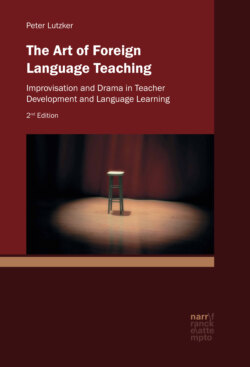Читать книгу The Art of Foreign Language Teaching - Peter Lutzker - Страница 65
На сайте Литреса книга снята с продажи.
6.3.3 Games of Listening and Perceiving
ОглавлениеThese are games which involve a heightened awareness of listening and perceiving. They require a high level of awareness and trust in one’s partner, requiring each participant in turn, to let go and just follow the other. Despite their differences, each of these different games has strong elements of giving and receiving. In Blind Walk, half the participants close their eyes and walk wherever they want and at whatever speed they want, while being ‘navigated’ through the room by their seeing partners. Depending on the number of people in the group, the varying speeds of the different pairs and the size of the room this game can sometimes become very challenging for the ‘seeing half’ of each pair who is responsible for avoiding all types of collisions. For the ‘blind’ participant, the sensation of wandering freely throughout a room without seeing anything, wholly dependent on being led by a partner who is intently watching out that no one will get hurt, calls for and creates a deep level of trust. When done to music it is called Guardian Angel and creates the feeling of dancing freely with one’s eyes closed. The partners then change roles and afterwards there is a brief feedback exchange between them.
For the game Pivot Dance music is required. The range of music used is relatively broad, from dance music such as tangos to calmer and more lyrical music. The rule is that at the moment when your partner stops dancing, you then start dancing. The structure of the Pivot Dance invites you to do nothing while your partner is dancing except to watch her and wait until she finishes her turn. This back and forth can last any period of time, i.e. there are both short and long sequences in which one or the other is dancing. This exercise is generally one of the most popular of all the games during the workshops, and it is a very beautiful exercise to watch as one can often see how in the developing relation of the dance of one person to the dance of the other a unified whole can emerge, although all is improvised in the moment. This game can be done either simultaneously by half the group while the other half watches, or, at a more advanced level, by pairs doing this in front of the others:
I love the Pivot Dance because it has a very poetic dimension. This dance is about receiving and giving … Beginner improvisers often feel they need to come up with good ideas or be funny. This structure invites you to do nothing until your partner finishes her turn. The stress of feeling you need to come up with something often stops you from seeing what your partner is doing, or from receiving the world. Through this structure you get to realize that what makes good stories has nothing to do with coming up with good ideas. It’s more to do with how you receive the world that is going to make stories happen. So it’s not about what you do, but about how you receive what is happening around you. That creates a profound shift in how to understand improvisation. Up to that point you could be forgiven for thinking that the success of an improvisation depended on what you did. And here, you get these very moving stories and relationships that appear not so much from what you do, but from the space you give to your partner. (Interview 3 )
